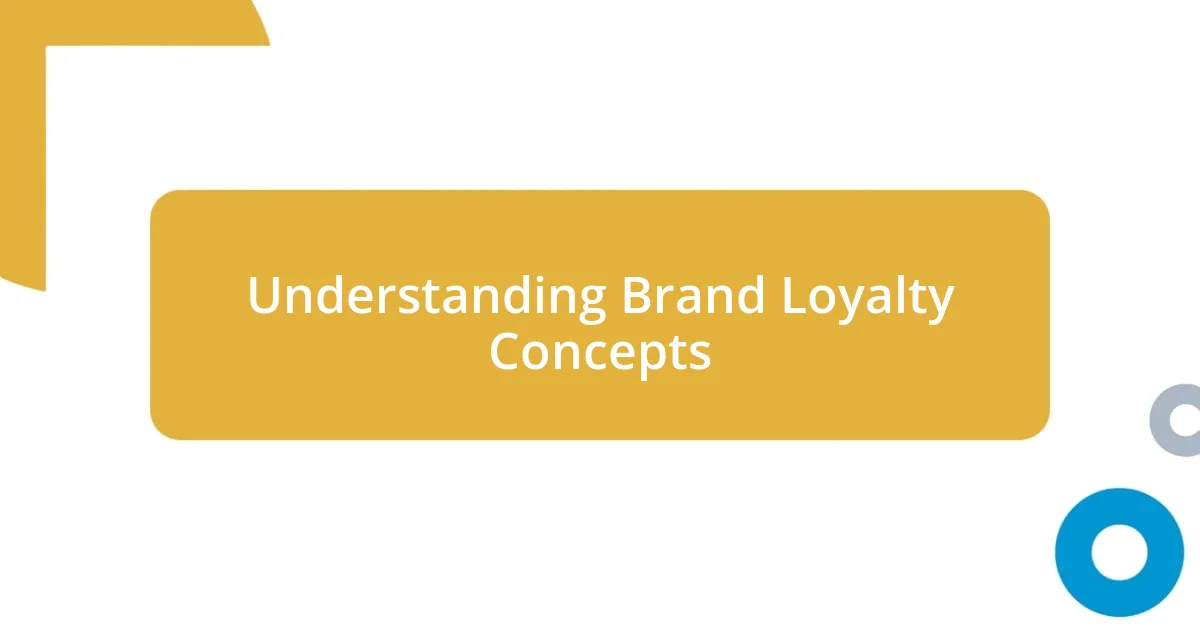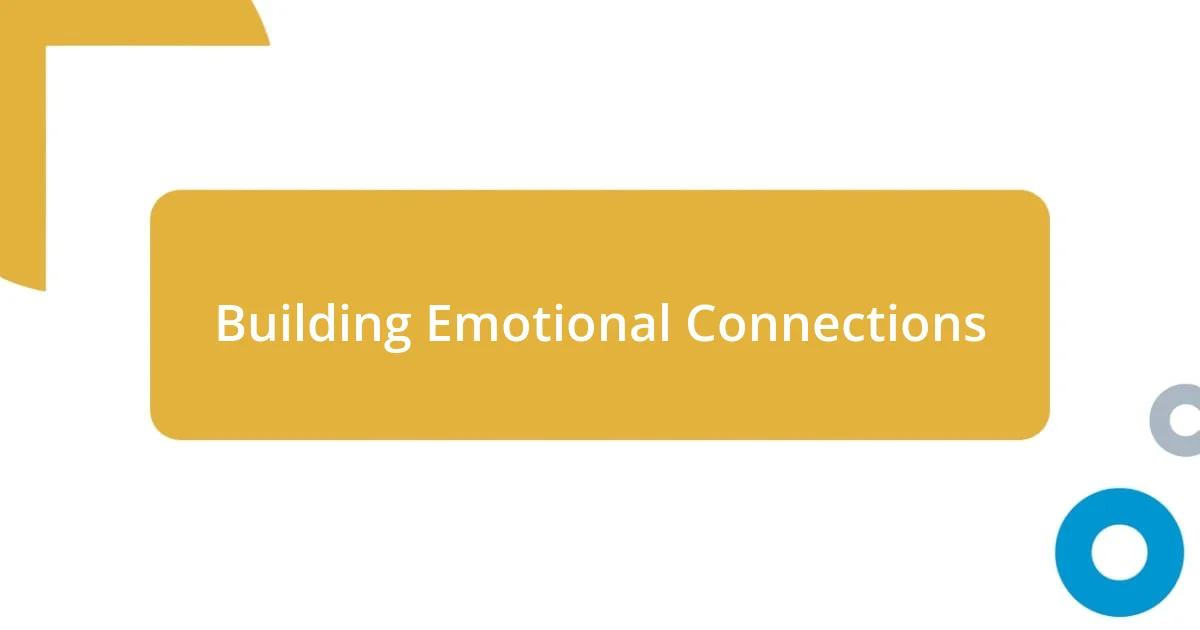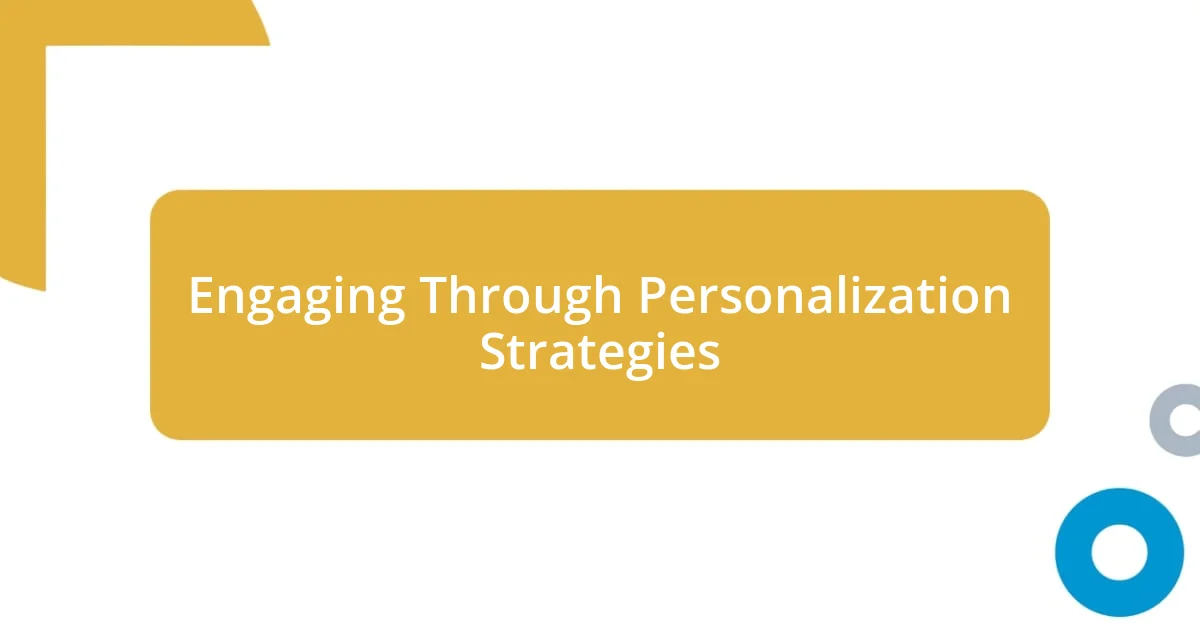Key takeaways:
- Brand loyalty is driven by emotional connections and trust, often resulting in a commitment to repeatedly purchase a brand despite competition.
- Creating personalized interactions and fostering community significantly enhance customer engagement and emotional ties to the brand.
- Brands must adapt to changing consumer needs by offering tailored services and innovative solutions, which strengthens customer loyalty and trust.

Understanding Brand Loyalty Concepts
Brand loyalty often stems from a combination of emotional connection and trust. I remember when I bought the same brand of coffee for years, not just for the taste, but because it reminded me of Sunday mornings with my family. Isn’t it fascinating how brands can become intertwined with our personal stories and memories?
At its core, brand loyalty can be understood as a commitment to repurchase or continue using a brand despite the competition. I once faced a dilemma when a competitor released a sensational new product. Yet, I found myself returning to my beloved brand; the familiarity and reliability had me hooked. Isn’t that a testament to the power of emotional loyalty over mere convenience?
Another concept worth noting is the difference between active and passive loyalty. Active loyalty reflects a deliberate choice, like when I actively seek out a local bakery I cherish, while passive loyalty might mean I stick with a brand simply out of habit. This distinction makes me wonder—how aware are we of our loyalty and the reasons behind it? Understanding these nuances can profoundly influence our approach to brand engagement.

Building Emotional Connections
Creating emotional connections with customers is essential for fostering brand loyalty. I recall an experience with a shoe brand that went beyond just offering a quality product. The minute I slipped on a pair, I was reminded of the exhilarating feeling I had at my first marathon. That nostalgic pull was powerful—it turned a simple shoe purchase into a cherished memory.
Emotional connections can develop through storytelling. I once attended a brand event that shared testimonials from individuals whose lives were positively impacted by the brand. It struck a chord with me; I was drawn into their stories and, in turn, felt a deeper connection with the brand itself. This emotional engagement can transform the way customers perceive and experience the brand, ultimately building a loyal following.
Moreover, creating a sense of community can further deepen these connections. I often find myself participating in online forums where fellow fans share their experiences with a specific brand I adore. Engaging in conversations about our shared passions makes me feel like I belong. It’s incredible how a simple brand can unite people, reinforcing our emotional ties and commitment to it.
| Aspect | Emotional Connection |
|---|---|
| Personal Memories | Triggers nostalgia, enriching brand experience |
| Storytelling | Deepens engagement, creates relatability |
| Community Building | Fosters a sense of belonging and shared interests |

Creating Consistent Customer Experiences
Creating consistent customer experiences is a vital aspect of cultivating brand loyalty. I once frequented a particular bookstore where each visit felt like a warm embrace. The staff recognized me, always offered personalized recommendations, and made me feel like part of their community. It wasn’t just about purchasing books; it was the experience that kept me coming back.
To ensure a consistent customer experience, brands should focus on various key elements:
- Staff Training: Empower employees to embody brand values and engage genuinely with customers.
- Omnichannel Consistency: Provide a seamless experience across various platforms, like online and in-store, maintaining the same quality and treatment.
- Feedback Loops: Regularly seek and act on customer feedback to refine and enhance the service experience continually.
- Brand Messaging: Maintain cohesive messaging and aesthetics across all channels to reinforce brand identity and customer recognition.
When I think about my go-to café, I appreciate how every cup of coffee and the friendly banter is a reminder of why I keep returning. This consistency creates a sense of security and familiarity that strengthens my loyalty.

Engaging Through Personalization Strategies
Engaging customers through personalization strategies is incredibly effective. I remember the thrill of receiving a birthday discount from my favorite clothing store. It felt like they truly valued me as an individual rather than just another shopper. This small gesture made my special day even brighter and reinforced my loyalty towards that brand.
In my experience, tailored communication can significantly enhance customer engagement. I often receive emails that suggest products based on my previous purchases—it’s like they already know my taste! When a company shows that they understand my preferences, it creates a sense of intimacy that I genuinely appreciate. Have you ever felt like a brand “gets” you? It’s a powerful feeling that goes beyond mere transactions.
One of the most memorable personalization strategies I encountered involved an online skincare brand. They sent me a personal message after I made my first purchase, asking how I liked the product. This not only made me feel special but also opened a dialogue. It invited me to share my feedback, which reinforced my connection to the brand. Isn’t it amazing how these personalized touches can transform a brand from just a name into a companion on our journey?

Measuring and Analyzing Customer Feedback
Measuring and analyzing customer feedback is crucial to understanding how to foster brand loyalty. I always think about the time I received a post-purchase survey from a tech company. They genuinely wanted to know what I thought about the gadget I bought, not just in terms of satisfaction but also in how I used it. This kind of proactive approach signals to customers that their opinions matter, bridging the gap between brand and consumer.
When I analyze customer feedback, I often look for trends and themes that emerge over time. I recall discovering that a beloved local diner struggled with long wait times during lunch hours. Instead of ignoring this issue, they proactively addressed it, leading to happier customers and an even busier establishment. Isn’t it fascinating how listening can turn a challenge into an opportunity?
Surveys, social media interactions, and direct conversations provide a wealth of insights. But I find that sometimes, informal chats can be just as revealing. I often ask friends what they think of a brand or their latest purchase. Their candid inputs offer insights that are often missed in structured feedback channels. Have you ever had a friend recommend a brand that you hadn’t considered? Those genuine recommendations speak volumes about trust, which is a cornerstone of brand loyalty.

Developing Loyalty Programs that Work
Creating loyalty programs that genuinely resonate with customers requires thoughtfully tailored strategies. For instance, I once participated in a coffee shop’s rewards program that felt less like a transaction and more like a community experience. Every tenth coffee earned me a free drink, but it was the friendly barista who remembered my usual order that really made me feel valued. Have you ever felt connected to your local cafe in that way? It’s those personal touches that encourage us to keep coming back.
In my experience, exclusive access can significantly boost customer loyalty. I remember when a popular gym offered its members-only classes. The thrill of participating in a special workout session, away from the crowds, made me appreciate my membership even more. That sense of exclusivity felt like being part of an elite club, encouraging me to renew my membership year after year. Doesn’t it make you think about how a little exclusivity could elevate a customer’s experience?
Designing a loyalty program isn’t just about discounts; it’s about building relationships. A boutique where I frequently shop introduced a referral program that rewarded both me and the friends I brought along. I not only got a discount, but my friend also enjoyed a welcome perk, creating a shared joy that extended beyond shopping. Have you ever shared an experience that was so rewarding, both personally and socially? That’s what loyalty should feel like—a mutual investment in a relationship that transcends mere transactions.

Adapting to Changing Consumer Needs
Adapting to the ever-changing needs of consumers is essential for any brand wanting to maintain loyalty. I remember when a clothing retailer I loved began offering personalized styling services based on my past purchases. It felt like they were genuinely listening to my preferences and adapting to what I needed at that moment. Have you ever had a brand surprise you with a service that seemed tailored just for you? That kind of attention speaks volumes.
Moreover, I’ve witnessed brands pivoting their offerings during unexpected times, like when many restaurants introduced takeout and delivery options during the pandemic. One local eatery even added a family meal option to accommodate larger households, making it easier for busy parents to feed their families without fuss. Isn’t it impressive how brands can quickly innovate in response to shifting consumer demands? This nimbleness can build trust and show that they prioritize our needs.
Another example is when my favorite beauty brand started offering virtual consultations. They recognized that many consumers were hesitant to shop in-store and sought to create a personalized experience online instead. Personally, I found this incredibly helpful for selecting products, as it gave me the assurance I sought in a product recommendation. How often do we appreciate a brand that meets us where we are? These adaptive strategies not only cultivate loyalty but also strengthen the connection we feel to the brand.














